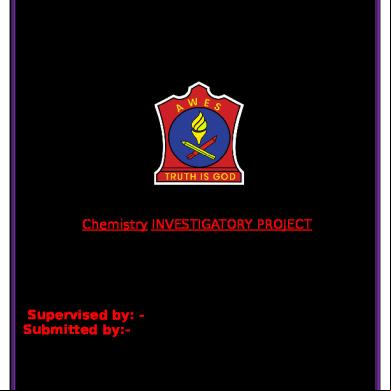Project File 6c122n
This document was ed by and they confirmed that they have the permission to share it. If you are author or own the copyright of this book, please report to us by using this report form. Report 2z6p3t
Overview 5o1f4z
& View Project File as PDF for free.
More details 6z3438
- Words: 856
- Pages: 12
2019-2020
Chemistry INVESTIGATORY PROJECT
ELECTROLYSIS OF POTASSIUM IODIDE
Supervised by: Submitted by:Mr. AMARNATH SINHA PGT, chemistry
AMIT CHOUDHARY Class: - XII ‘B’ Army Public School
Certificate It is certified that the project work entitled “Electrolysis of Potassium Iodide” as a record of investigatory work done by the student AMIT CHOUDHARY during the academic year 2019-20 under my guidance and supervision in practical fulfillment of the requirement for the “All India Senior School Certificate Examination” conducted by CBSE.
Signature of external examiner
Signature of chemistry teacher
Contents 1. Certificate
2
2. Acknowledgement
4
3. Objective
5
4. Introduction
6
5. Experiment:i.
Aim
8(i)
ii. Materials & Equipment’s
8(ii)
iii. Theory
9
iv. Procedure
10
v.Observations
12
vi. Result
13
6. Bibliography
14
+ Soft Copy (CD)
Acknowledgement I wish to express my deep gratitude and sincere thanks to the Principal, Dr. Tabassum Khan for her encouragement and for all the facilities that she provided for this project work. I extend my hearty thanks to Dr. Amarnath Sinha, our Chemistry Teacher, who guided me to the successful completion of this project. I take this opportunity to express my deep sense of gratitude for his invaluable guidance, constant encouragement, immense motivation, which has sustained my efforts at all stages of this Project work. I can’t forget to offer my sincere thanks to my parents and also to my classmates who helped me to carry out this project work successful and for their valuable advice and , which I received from them time to time.
AMIT CHOUDHARY Class: - XII – B
Army Public School, Jodhpur
Objective of Project IN THIS PROJECT MY AIM IS TO STUDY THE ELECTROLYSIS PRODUCT OF POTASSIUM IODIDE BASED ON THE BREAKING OF THE IONIC COMPOUND WITH THE HELP OF ELECTRICITY
Introduction Potassium iodide is the potassium salt form of iodide, a naturally occurring substance. Potassium iodide can be used as an expectorant to thin mucus and loosen congestion in your chest and throat. Potassium iodide is used in people with chronic breathing problems that can be complicated by thick mucus in the respiratory tract, such as asthma, chronic bronchitis, or emphysema. Potassium iodide is used to thin mucus and loosen congestion in people with chronic breathing problems that can be complicated by thick mucus in the respiratory tract. Potassium iodide can cause thyroid problems, high potassium levels in your blood, or iodide poisoning. Call your doctor at once if you have swelling in your neck or throat, chest pain, irregular heart rate, muscle weakness, tingly feeling, pain burning in your mouth, severe headache.
Experiment
Aim: In this project our basic aim is to study the electrolysis products of Potassium Iodide (KI).
Materials and Equipment’s: U Tube Stand, Electrodes, Potassium Iodide Solution, Battery Eliminator.
Theory Electrolysis- It is defined as a process of decomposition of an electrolyte by the age of electricity through its aqueous solution or molten (fused) state. Mechanism of Electrolysis- Whenever an electrolyte is dissolved in water or is taken in the molten state, the electrolyte dissociates to produce positively and negatively charged ions. On ing electric current, the positively charged ions move towards the cathode and hence are called cations, whereas the negatively charged ions move towards the anode and hence are called anions. On reaching their respective electrodes, ions lose their charge and become neutral. The cations accept electrons from the cathode to become neutral species. Thus, oxidation occurs at the anode while reduction takes place at the anode. The conversion of ions into neutral species at their respective electrodes is called Primary change. The product formed as a result of primary change may be collected as such or it may go under a Secondary change to form the final products.
Procedure 1.Prepare 0.1M solution of potassium iodide. 2.Fix a U- shaped tube in a stand and insert two graphite electrodes into both ends of the U- tube through the corks. 3.Assemble the apparatus as shown in the figure. 4.Take about 30ml of 0.1M solution of potassium iodide in a 100ml beaker add five or six drops of phenolphthalein solution and five to six drops of freshly prepared starch solution. 5.Stir the solution and transfer it into an electrolysis – tube fitted with graphite electrodes. 6. electric current through the electrolyte and observe the appearance of color. 7.A pink color appears at the cathode and a violet color appears at the anode. Bubble formation also occurs on the surface of the cathode.
Observations TEST SOLUTIONS
OBSERVATION S
INFERENCE
Aqueous solution of potassium iodide with five drops of phenolphthalein and five drops of starch solution.
At the anode, violet color.
Free iodine is evolved. I.OH– ion is formed II. Hydrogen is evolved
At the cathode: I. Pink color II. Formation of bubbles
Result: In the electrolysis of an aqueous solution of potassium iodide, I- ions are oxidized at the anode preferentially to water molecules. Violet color at anode is due to iodine. Pink color at cathode is due to formation of OHions which renders the solution alkaline. OH- ions give pink color with phenolphthalein.
Bibliography 1. Chemistry NCERT Textbook 2. Comprehensive Practical Lab Manual 3. Google.com 4. Wikipedia.org
Chemistry INVESTIGATORY PROJECT
ELECTROLYSIS OF POTASSIUM IODIDE
Supervised by: Submitted by:Mr. AMARNATH SINHA PGT, chemistry
AMIT CHOUDHARY Class: - XII ‘B’ Army Public School
Certificate It is certified that the project work entitled “Electrolysis of Potassium Iodide” as a record of investigatory work done by the student AMIT CHOUDHARY during the academic year 2019-20 under my guidance and supervision in practical fulfillment of the requirement for the “All India Senior School Certificate Examination” conducted by CBSE.
Signature of external examiner
Signature of chemistry teacher
Contents 1. Certificate
2
2. Acknowledgement
4
3. Objective
5
4. Introduction
6
5. Experiment:i.
Aim
8(i)
ii. Materials & Equipment’s
8(ii)
iii. Theory
9
iv. Procedure
10
v.Observations
12
vi. Result
13
6. Bibliography
14
+ Soft Copy (CD)
Acknowledgement I wish to express my deep gratitude and sincere thanks to the Principal, Dr. Tabassum Khan for her encouragement and for all the facilities that she provided for this project work. I extend my hearty thanks to Dr. Amarnath Sinha, our Chemistry Teacher, who guided me to the successful completion of this project. I take this opportunity to express my deep sense of gratitude for his invaluable guidance, constant encouragement, immense motivation, which has sustained my efforts at all stages of this Project work. I can’t forget to offer my sincere thanks to my parents and also to my classmates who helped me to carry out this project work successful and for their valuable advice and , which I received from them time to time.
AMIT CHOUDHARY Class: - XII – B
Army Public School, Jodhpur
Objective of Project IN THIS PROJECT MY AIM IS TO STUDY THE ELECTROLYSIS PRODUCT OF POTASSIUM IODIDE BASED ON THE BREAKING OF THE IONIC COMPOUND WITH THE HELP OF ELECTRICITY
Introduction Potassium iodide is the potassium salt form of iodide, a naturally occurring substance. Potassium iodide can be used as an expectorant to thin mucus and loosen congestion in your chest and throat. Potassium iodide is used in people with chronic breathing problems that can be complicated by thick mucus in the respiratory tract, such as asthma, chronic bronchitis, or emphysema. Potassium iodide is used to thin mucus and loosen congestion in people with chronic breathing problems that can be complicated by thick mucus in the respiratory tract. Potassium iodide can cause thyroid problems, high potassium levels in your blood, or iodide poisoning. Call your doctor at once if you have swelling in your neck or throat, chest pain, irregular heart rate, muscle weakness, tingly feeling, pain burning in your mouth, severe headache.
Experiment
Aim: In this project our basic aim is to study the electrolysis products of Potassium Iodide (KI).
Materials and Equipment’s: U Tube Stand, Electrodes, Potassium Iodide Solution, Battery Eliminator.
Theory Electrolysis- It is defined as a process of decomposition of an electrolyte by the age of electricity through its aqueous solution or molten (fused) state. Mechanism of Electrolysis- Whenever an electrolyte is dissolved in water or is taken in the molten state, the electrolyte dissociates to produce positively and negatively charged ions. On ing electric current, the positively charged ions move towards the cathode and hence are called cations, whereas the negatively charged ions move towards the anode and hence are called anions. On reaching their respective electrodes, ions lose their charge and become neutral. The cations accept electrons from the cathode to become neutral species. Thus, oxidation occurs at the anode while reduction takes place at the anode. The conversion of ions into neutral species at their respective electrodes is called Primary change. The product formed as a result of primary change may be collected as such or it may go under a Secondary change to form the final products.
Procedure 1.Prepare 0.1M solution of potassium iodide. 2.Fix a U- shaped tube in a stand and insert two graphite electrodes into both ends of the U- tube through the corks. 3.Assemble the apparatus as shown in the figure. 4.Take about 30ml of 0.1M solution of potassium iodide in a 100ml beaker add five or six drops of phenolphthalein solution and five to six drops of freshly prepared starch solution. 5.Stir the solution and transfer it into an electrolysis – tube fitted with graphite electrodes. 6. electric current through the electrolyte and observe the appearance of color. 7.A pink color appears at the cathode and a violet color appears at the anode. Bubble formation also occurs on the surface of the cathode.
Observations TEST SOLUTIONS
OBSERVATION S
INFERENCE
Aqueous solution of potassium iodide with five drops of phenolphthalein and five drops of starch solution.
At the anode, violet color.
Free iodine is evolved. I.OH– ion is formed II. Hydrogen is evolved
At the cathode: I. Pink color II. Formation of bubbles
Result: In the electrolysis of an aqueous solution of potassium iodide, I- ions are oxidized at the anode preferentially to water molecules. Violet color at anode is due to iodine. Pink color at cathode is due to formation of OHions which renders the solution alkaline. OH- ions give pink color with phenolphthalein.
Bibliography 1. Chemistry NCERT Textbook 2. Comprehensive Practical Lab Manual 3. Google.com 4. Wikipedia.org










